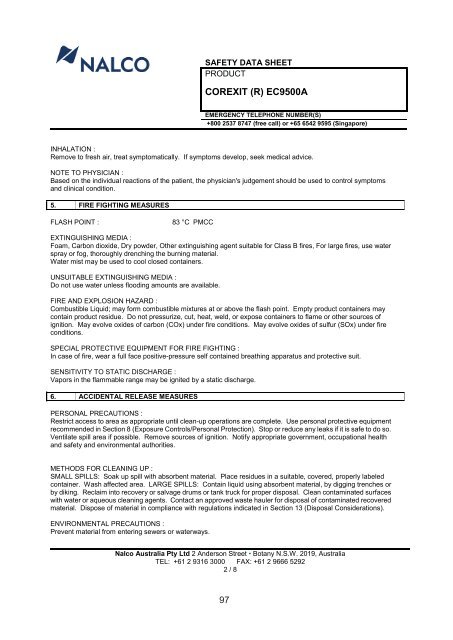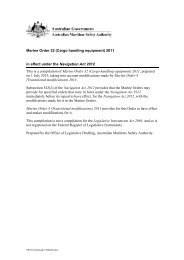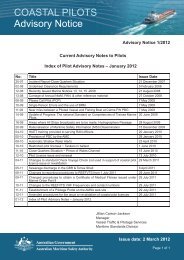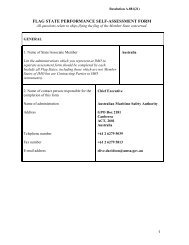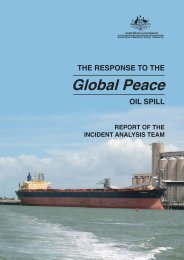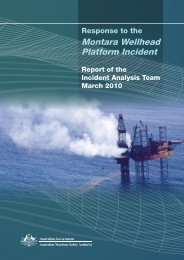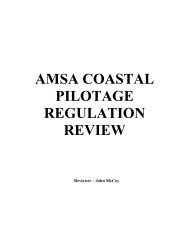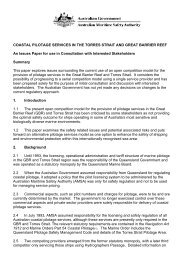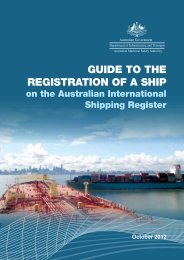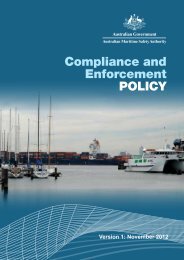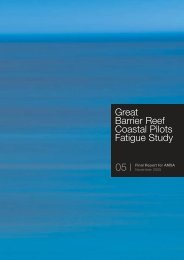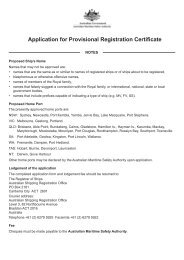Slickgone NS - Australian Maritime Safety Authority
Slickgone NS - Australian Maritime Safety Authority
Slickgone NS - Australian Maritime Safety Authority
Create successful ePaper yourself
Turn your PDF publications into a flip-book with our unique Google optimized e-Paper software.
SAFETY DATA SHEET<br />
PRODUCT<br />
COREXIT (R) EC9500A<br />
EMERGENCY TELEPHONE NUMBER(S)<br />
+800 2537 8747 (free call) or +65 6542 9595 (Singapore)<br />
INHALATION :<br />
Remove to fresh air, treat symptomatically. If symptoms develop, seek medical advice.<br />
NOTE TO PHYSICIAN :<br />
Based on the individual reactions of the patient, the physician's judgement should be used to control symptoms<br />
and clinical condition.<br />
5. FIRE FIGHTING MEASURES<br />
FLASH POINT : 83 °C PMCC<br />
EXTINGUISHING MEDIA :<br />
Foam, Carbon dioxide, Dry powder, Other extinguishing agent suitable for Class B fires, For large fires, use water<br />
spray or fog, thoroughly drenching the burning material.<br />
Water mist may be used to cool closed containers.<br />
U<strong>NS</strong>UITABLE EXTINGUISHING MEDIA :<br />
Do not use water unless flooding amounts are available.<br />
FIRE AND EXPLOSION HAZARD :<br />
Combustible Liquid; may form combustible mixtures at or above the flash point. Empty product containers may<br />
contain product residue. Do not pressurize, cut, heat, weld, or expose containers to flame or other sources of<br />
ignition. May evolve oxides of carbon (COx) under fire conditions. May evolve oxides of sulfur (SOx) under fire<br />
conditions.<br />
SPECIAL PROTECTIVE EQUIPMENT FOR FIRE FIGHTING :<br />
In case of fire, wear a full face positive-pressure self contained breathing apparatus and protective suit.<br />
SE<strong>NS</strong>ITIVITY TO STATIC DISCHARGE :<br />
Vapors in the flammable range may be ignited by a static discharge.<br />
6. ACCIDENTAL RELEASE MEASURES<br />
PERSONAL PRECAUTIO<strong>NS</strong> :<br />
Restrict access to area as appropriate until clean-up operations are complete. Use personal protective equipment<br />
recommended in Section 8 (Exposure Controls/Personal Protection). Stop or reduce any leaks if it is safe to do so.<br />
Ventilate spill area if possible. Remove sources of ignition. Notify appropriate government, occupational health<br />
and safety and environmental authorities.<br />
METHODS FOR CLEANING UP :<br />
SMALL SPILLS: Soak up spill with absorbent material. Place residues in a suitable, covered, properly labeled<br />
container. Wash affected area. LARGE SPILLS: Contain liquid using absorbent material, by digging trenches or<br />
by diking. Reclaim into recovery or salvage drums or tank truck for proper disposal. Clean contaminated surfaces<br />
with water or aqueous cleaning agents. Contact an approved waste hauler for disposal of contaminated recovered<br />
material. Dispose of material in compliance with regulations indicated in Section 13 (Disposal Considerations).<br />
ENVIRONMENTAL PRECAUTIO<strong>NS</strong> :<br />
Prevent material from entering sewers or waterways.<br />
Nalco Australia Pty Ltd 2 Anderson Street • Botany N.S.W. 2019, Australia<br />
TEL: +61 2 9316 3000 FAX: +61 2 9666 5292<br />
2 / 8<br />
97


